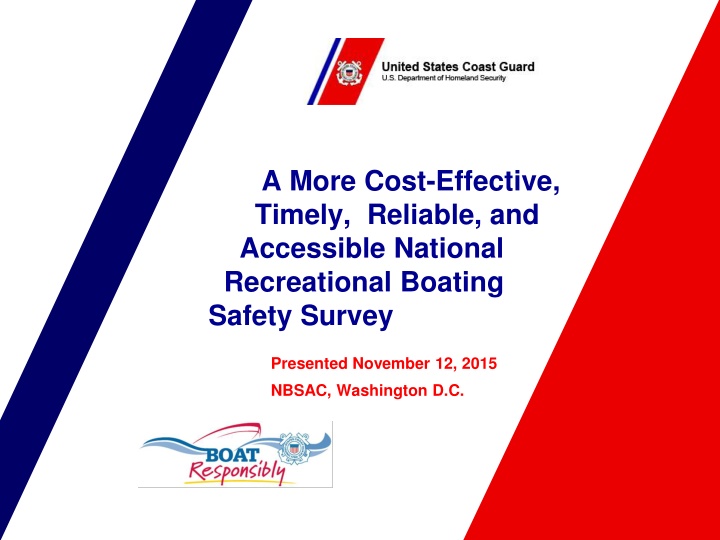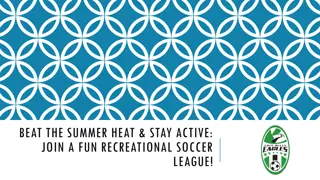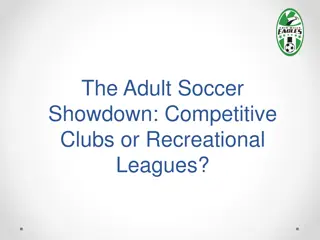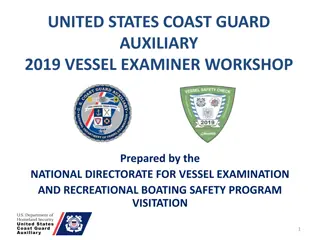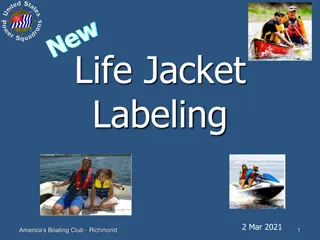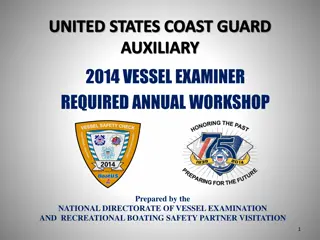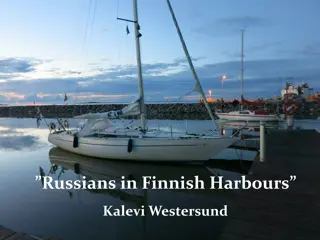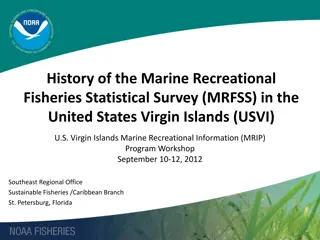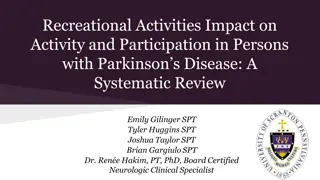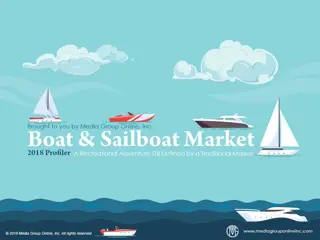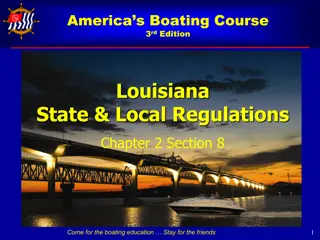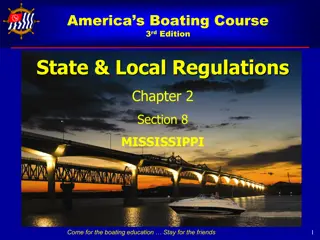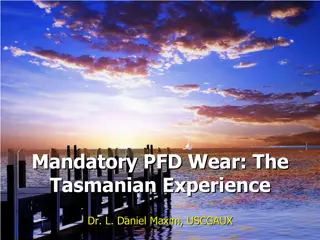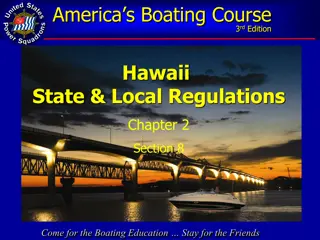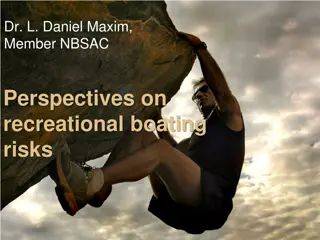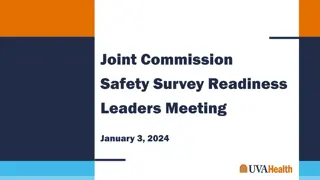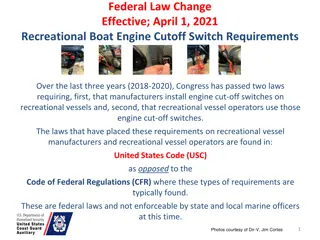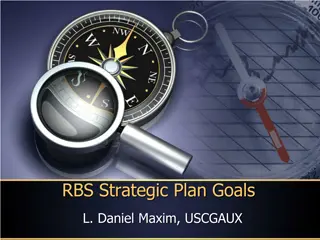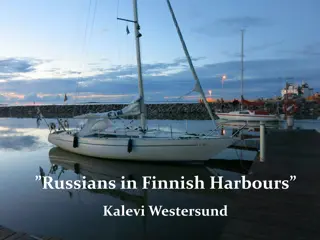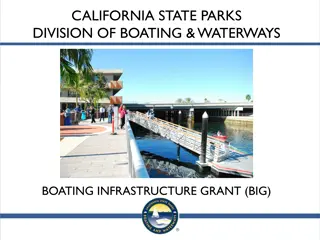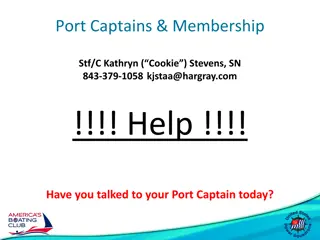National Recreational Boating Safety Survey Review
The 2015 National Recreational Boating Safety Survey (NRBSS) presented key findings at the NBSAC in Washington, D.C. The survey aimed to provide cost-effective, timely, reliable, and accessible data for the USCG, state agencies, and industry. It highlighted the importance, complexities, progress, and recommendations for future NRBSS initiatives, emphasizing the need for consistent data to estimate boating participants and exposure measures. The survey outlined objectives to guide future surveys and ensure efficient distribution and utilization of results within six months of completion.
Download Presentation

Please find below an Image/Link to download the presentation.
The content on the website is provided AS IS for your information and personal use only. It may not be sold, licensed, or shared on other websites without obtaining consent from the author.If you encounter any issues during the download, it is possible that the publisher has removed the file from their server.
You are allowed to download the files provided on this website for personal or commercial use, subject to the condition that they are used lawfully. All files are the property of their respective owners.
The content on the website is provided AS IS for your information and personal use only. It may not be sold, licensed, or shared on other websites without obtaining consent from the author.
E N D
Presentation Transcript
USCG Logo A More Cost-Effective, Timely, Reliable, and Accessible National Recreational Boating Safety Survey Presented November 12, 2015 NBSAC, Washington D.C.
Presentation Outline 1 Importance of NRBSS 2 Complexities 3 Progress Next NRBSS 4 Recommendations Next NRBBS 5 Questions 2
1. The Potential of the USCGs NRBSS is Uniquely Important The Size and Scope of the Sample The Data will be Information Beneficial to USCG, State Agencies and Industry Consistent Data to Estimate Numbers and Characteristics of Boating Participants Data Necessary to Estimate Different Measures of Boating Exposure 3
2. Complexities Associated with Conducting the NRBSS Contribute to the COST The Accelerating Change of the Survey Environment Recall - Days, Hours, Persons Aboard Boats Sampling Frame Registered Boat Owners for Some States & Non-registered Boat Owners Defining Terms Accurately in Understandable Way Comparing Findings Across Surveys that Employ Different Sampling Frames, Questions, Methods, 4
3. Progress Toward Conducting the Next NRBSS 3.1. Confirming Objectives to Guide the Scope and Design of Future NRBSSs. o Generate valid and reliable estimates of the numbers and types of both registered and non-registered boats owned and that are operated out on the water during a given year. o Collect data required to produce different exposure estimates (e.g., boating days, boat hours, person hours) for a given year. o Produce national estimates of the numbers, and their socio- economic characteristics, of boating participants and the owners of different types of registered and non-registered boats. 5
3.1. Confirming Objectives to Guide the Scope and Design of Future NRBSSs oProduce and suitably distribute results of the NRBSS within six months of surveys being completed. o Make the NRBSS data conveniently accessible in a format that encourages its effective utilization by different agencies, organizations and the boating industry. o Employ the NRBSS to produce cutting-edge analytics and the development of forecasting and simulation models. 6
3. Progress Toward Conducting the Next NRBSS 3.2. Determining the USCG NRBSS Priority Data Number and types of un-registered boats Number of all boats taken out (operated) on the water States where boats are operated Amount of time (days, hours) boats are operated on the water Number of persons aboard boats operated on the water Socio-economic characteristics of boat owners Number of different persons that go out on boat participants 7
3. Progress Toward Conducting the Next NRBSS 3.3. Finalizing (15) Definitions of Important NRBSS Terms. RECREATIONAL BOATS/Vessels craft that are operated out on the water for recreational purposes, not for commercial purposes. Recreational boats include: outboard, inboard and stern-drive power boats, jet boats, pontoons, houseboats, sailboats, row boats, canoes, kayaks, dragon boats, personal watercraft (e.g., jet skis), inflatable boats, kite boards, stand-up paddleboards and sail boards. Recreational boats/vessels are also boats rented that are operated by the renter, but they not include captained charter or party boats, ferries, or cruise ships 8
3.3. Finalizing (15) Definitions of Important NRBSS Terms RECREATIONAL BOAT USE includes operation of, or presence on, a recreational boat/vessel out on the water, either while it is being prepared (e.g., supplied, fueled, launched) for immediate departure or while the boat is on the water away from its mooring A BOAT OWNER: a household, in which at least one person holds the title, registration, and/or ownership rights to a recreational boat 9
3. Progress Toward Conducting the Next NRBSS 3.4. Determined and reviewed the Cost of USCG National Boating Surveys and other National Survey Efforts Completed Surveys Estimated Cost Survey Year Survey 1. Household Participation Survey (Telephone) 17,322 $1.25 million 2012 NRBS 2. Trip Survey 40,406 $3.12 Million Telephone 25,447 Web 14,959 1. Household Participation Survey (Telephone) 20,140 2011 NRBS 2. Boat (Owner) Survey 32,568 $1.87 Million Mail 13,020 Telephone 19,548 2002 National Boating Survey 25,547 $1.53 Million 10
Progress Toward Conducting the Next NRBSS 3.5. Comprehensive review, and different measures of data, and methods employed to estimate exposure and risk ratios. 3.6. Wide-ranging review of different types of boating surveys (e.g., methods, samples, questions). 3.7. Meetings with USCG Division of Contracting and Acquisition in an Effort to Develop a More Specific FRP to Conduct the NRBSS. 11
Progress Toward Conducting the Next NRBSS 3.8. Meetings to Commence and More Quickly Navigate the OMB Survey Approval Process. USCG OMB Liaison Dept. of Homeland Security OMB Liaison OBM Staff 12
4. Our Recommendations for the Next NRBSS 4.1. Focus the Effort on Collecting Valid and Reliable Data Required to Estimate Exposure (National and States). 4.2. Consider an Every-Other-Year Survey Which is Feasible for $3 million ($1.5 million/year). More current exposure data, risk ratios, boating participant and participation information Changes in the boating and safety environment Data points for trend identification and analysis and modeling 13
4. Our Recommendations for the Next NRBSS 4.3. If, Instead, a Decision is Made to Conduct the Survey Every Three Years. 2017 or 18 2020 2023 Priority Data to Estimate Boating Exposure Data Priority Data to Estimate Boating Exposure Data Priority Data to Estimate Boating Exposure Data Special Emerging Topics Different Special Emerging Topics Additional Analytics 14
4. Our Recommendations for the Next NRBSS 4.4. Employ a Very Specific RFP and Contract. 4.5. Require that the Contractor Knows Boating & Has Previous Boating Research Experience Not Just Survey Methods. 4.6. Comparative Verification of the Findings. 4.7. Require and Enforce a Very Timely Release of the Findings. 4.8. Make it Easy to Acquire and Employ the Data and Encourage its Use and Analysis. 15
Contact information For further information, please contact: Dr. Ed Mahoney edmahoneymsu@gmail.com Department of Community Sustainability and the School of Planning, Design and Construction Michigan State University 131 Natural Resources Bldg. East Lansing, MI 48824-1222 Phone: 517-281-8202 Fax: 517-432-3597 16
